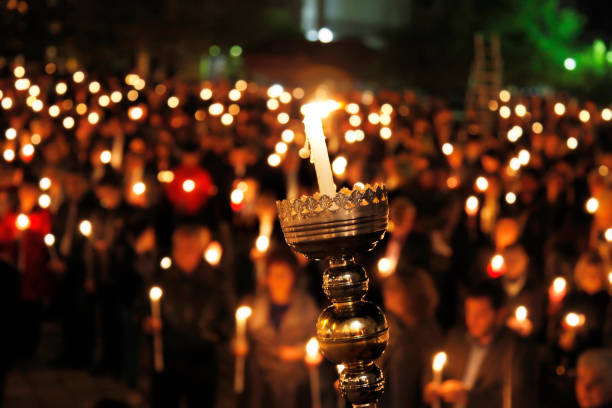
The Roman Missal and the Easter Vigil
Sunday Mar 31, 2024 7:13 am
By NEWS EDITOR
Awka,
Features
The Roman Missal and the Easter Vigil
The rubrics for Holy Saturday found in the Missale Romanum, editio typica tertia address several matters which will be helpful to those involved in the preparation of the celebration of the Easter Vigil.
Introduction to the Easter Vigil
The rubrics of the Missale Romanum remind us that this "mother of all vigils" is the "greatest and most noble of all solemnities and it is to be unique in every single Church" ( Missale Romanum, "Rubrics for the Easter Vigil" (EV), no.2). On this holy night, the Church keeps watch, celebrating the resurrection of Christ in the sacraments and awaiting his return in glory. It is the turning point of the Triduum, the Passover of the new covenant, which marks Christ's passage from death to life. Therefore, the Easter Vigil does not correspond to the usual Saturday evening Mass and its character is unique in the cycle of the liturgical year.
The Vigil, by its very nature, "ought to take place at night" (EV, no. 3). It is not begun before nightfall 1 and should end before daybreak on Easter Sunday. The celebration of the Easter Vigil takes the place of the Office of Readings (EV, no. 5).
The role of the deacon assisting the priest is highlighted in the new Missale, although it is noted that in his absence his duties may be exercised by the priest celebrant himself or by a concelebrant (EV, no. 6).
The Elements and Parts of the Easter Vigil
The Service of Light
In a suitable place outside the Church, a "blazing fire" ( rogus ardens) is to be prepared so that the people may gather around it and experience the flames dispelling the darkness and lighting up the night. Thus do the beauty of the fire, its warmth and its light, draw the liturgical assembly together. The rubrics, however, acknowledge that when this cannot be done adaptations may be made. The Missale also states that cross and candles are not to be carried in this procession (EV, no. 8).
Having reached the fire, the celebrant and faithful sign themselves with the sign of the cross while the priest says: In the name of the Father, and of the Son, and of the Holy Spirit (EV, no. 9). After this new beginning, he greets the people and then gives the instruction (EV, no. 9). As the celebrant blesses the fire he says the prayer with hands outstretched (EV, no. 10).
The Paschal Candle is brought forward. This candle should be made of wax, never be artificial, be renewed each year, be only one in number, and be of sufficiently large size that it may convey the truth that Christ is the light of the world. This description is developed in no. 94 of Built of Living Stones which reminds us that the Paschal Candle is the symbol of the "light of Christ, rising in glory," scattering the "darkness of our hearts and minds." "Above all, the Paschal Candle should be a genuine candle, the pre-eminent symbol of the light of Christ. Choice of size, design, and color should be made in relationship to the sanctuary in which it will be placed . . . " (Congregation for Divine Worship and the Discipline of the Sacraments, Circular Letter Concerning the Preparation and Celebration of the Easter Feasts [1988], no 82).
The candle is then prepared in rites which are no longer optional. The celebrant cuts a cross into the candle with a stylus. Then he makes the Greek letter Alpha above the cross, the letter Omega below it, and the four numerals of the current year between the arms of the cross, saying the words indicated. After these rites, the priest lights the candle from the new fire and says: May the light of Christ, rising in glory, dispel the darkness of our hearts and minds. (EV, no.14)
The organization of the procession is more clearly described in the new Missale Romanum. One of the ministers takes burning coals from the fire and places them in a censer (thurible) and the priest, in the usual way, places incense into it. The deacon, or in his absence another appropriate minister accepts the Easter candle from the celebrant and a procession is formed. The order of procession is the thurifer with smoking thurible, preceding the minister holding the candle, followed by the ministers and the priest and the people. All hold unlit candles (EV, no.15). Just as the children of Israel were guided at night by the pillar of fire, so Christians follow the risen Christ.
The places at which the proclamation, Light of Christ, are sung now differ from what was in the previous Missale.
The new places are: at the door of the Church (after which the priest lights his candle), in the middle of the Church (after which all light their candles), and before the altar, facing the people. The Missale instructs the deacon to place the candle in a large candle stand prepared either next to the ambo or in the middle of the sanctuary (EV, no. 17). The lights of the Church are then lit with the exception of the altar candles which are lit just before the intonation of the Gloria (EV, nos. 17 and 31).
Before the Easter Proclamation, the priest gives his candle to one of the ministers and blesses incense as at the Gospel during Mass. Having asked for and received the blessing, the deacon announces the Easter proclamation from the ambo or at a lectern. This poetic text captures the whole Easter mystery placed within the context of the economy of salvation. In the absence of a deacon the priest himself or another concelebrating priest may announce the Easter proclamation. If, however, a lay cantor announces the proclamation, the words, My dearest friends, up to the end of the invitation are omitted, along with the greeting, The Lord be with you (nos. 18-19). The reference to the Conference of Bishops adapting the text by inserting acclamations is no longer mentioned.
Liturgy of the Word
One of the unique aspects of the Easter Vigil is the recounting of the outstanding deeds of the history of salvation. These deeds are related in seven readings from the Old Testament chosen from the law and the prophets and two readings from the New Testament, namely from the apostles and from the gospel. Thus, the Lord "beginning with Moses and all the prophets" ( Lk 24.27, 44-45) meets us once again on our journey and, opening up our minds and hearts, prepares us to share in the breaking of the bread and the drinking of the cup. The faithful are encouraged to meditate on these readings by the singing of a responsorial psalm, followed by a silent pause, and then by the celebrant�s prayer. The Missale adds a sentence about the nine readings proposed, saying that "all of these must be read whenever it can be done, so that the character of a Vigil which takes place over some duration of time can be observed" (EV, no. 20).
The new Missale recognizes that "nevertheless, where grave pastoral circumstances demand it, the number of readings from the Old Testament may be reduced" (EV, no 21). At least three readings from the Old Testament should be read always including Exodus 14 (EV, no. 21). The reference found previously in the Missale to the possibility of having only two Old Testament readings in extreme necessity is omitted.
The Missale is very specific about the priest singing the Alleluia before the Gospel: "After the Epistle has been read, all rise, and the priest solemnly intones the Alleluia three times, raising his voice a step each time. All repeat the Alleluia each time. If necessary, the psalmist intones the Alleluia. Mention is then made of the psalmist or cantor singing Psalm 117 and the people responding, 'Alleluia' (EV, no. 34). This psalm is often recited by the apostles in their Easter preaching" (Acts 4.11-12; Mt 21.42; Mk 12.10; Lk 20.17).
The Missale directs explicitly that the homily, even if it is brief, is not to be omitted (EV, no.36). This requires that the homilist carefully prepare and craft the homily so that it captures the tremendous mysteries being celebrated on this most holy of nights.
Liturgy of Baptism
The Missale has reorganized the rubrics for this entire section of the Vigil (nos. 37-58). Nevertheless, the Rite of Christian Initiation of Adults should always be consulted in conjunction with the rubrics mentioned here in the Missale. This is especially true when Baptisms are taking place by means of immersion.
Christ�s Passover and ours are given full expression when baptismal water is blessed in the font and when the Christian initiation of adults, or, at least the baptism of infants, takes place at the Easter Vigil. Even if there are no candidates for baptism, the blessing of baptismal water should take place in parish churches. At the very least, baptism should be commemorated by the blessing of water intended for sprinkling upon the people.
The rubrics describe two instances of Baptism at the Vigil. If there is a procession to the baptistery or the font, the catechumens are called forward and presented by their godparents. If there are children, they are carried by their parents and godparents to the front of the assembly. Those who are to be baptized, along with their godparents, are led first by a minister with the Easter candle; the other ministers, deacons and priest follow after them. This procession is accompanied by the singing of the Litany of the Saints. The priest then gives the introductory statement.
If the Baptisms take place in the sanctuary, the priest makes the introductory statement and this is followed by the singing of the Litany of the Saints.
When there are no Baptisms and the font is not to be blessed, the litany is omitted and the blessing of water takes place at once (EV, nos. 39-41).
The Missale reminds the celebrant that during the blessing of the water his hands are outstretched (EV, no.44).
Numbers 48 to 53 of the rubrics for the Easter Vigil of the Missale Romanum describe the initiation process. As was mentioned before, it is important to closely consult the Rite of Christian Initiation of Adults on this matter. Number 48 of the rubrics for the Easter Vigil mentions that after the renunciation and profession of faith "if the anointing with the Oil of Catechumens did not take place beforehand, as part of the immediate preparatory rites, it takes place at this moment." Of course no. 33 of the Rite of Christian Initiation of Adults points out: "The National Conference of Catholic Bishops approves the omission of the anointing with the oil of catechumens both in the celebration of baptism and in the optional preparation rites for Holy Saturday. Thus, anointing with the oil of catechumens is reserved for use in the period of the catechumenate and in the period of purification and enlightenment, and is not to be included in the purification rites on Holy Saturday or in the celebration of initiation at the Easter Vigil or at another time."
Number 49 of the rubrics for the Easter Vigil notes that when there are many to be baptized, the priest may ask for the renewal of baptismal promises of all present immediately after the profession of faith made by those to be baptized, along with the godparents and parents.
The celebration of Confirmation is to take place in the sanctuary as indicated in the Pontifical or the Roman Ritual.
Liturgy of the Eucharist
Care should be taken that, particularly in regard to this night's celebration of the Eucharist, the liturgy is not done in haste and that all the rites and words should be given their full force.
The Missale has incorporated into itself rubrics found in nos. 241-243 of the Rite of Christian Initiation of Adults. These allow for a commemoration of the baptized and their godparents to be made in the Eucharistic Prayer. Proper formulas are found in the Roman Missal for each of the Eucharistic prayers (EV, no.63). The Rite of Christian Initiation of Adults indicates that these formulas are found in the section for ritual Masses, "Christian Initiation: Baptism."
The Missale reminds the priest that before he says, This is the Lamb of God, he may make a brief remark to the neophytes about their first Communion and "about the preciousness of so great a mystery, which is the climax of initiation and the center of the Christian life" (EV, no. 64). In no. 65 the rubrics for the Easter Vigil indicate the desirability for the neophytes as well as all the faithful, if the diocesan Bishop consents, to receive Communion under both kinds.
The Missale provides a solemn blessing to conclude the liturgy (EV, no.69). It is used in place and can presently be found in the Sacramentary at no. 6, "Easter Vigil and Easter Sunday." It is also possible to use the formula of the final blessing in the Order of Baptism for Children, according to circumstances.
The very last rubric reminds us that "the Easter candle is lighted in all of the more solemn liturgical celebrations in the Season of Easter" (EV, no. 70).
Notes
1 When Holy Saturday occurs during Daylight Saving Time, pastoral planners should contact local weather stations for the time sunset will occur. Another 45 minutes or one hour should be added to that time in order to determine the approximate time of nightfall.
Culled from United States Conference of Catholic Bishops
Stories from the same author

Sports
John Cena announces his retirement from WWE after 22 years.
John Cena to step away from wrestling next year after a retirement tour
All Headlines
Categories
Return
Recent Stories

News
Unizik new Acting VC, Prof Carol Arinze-Umobi assumes duty, promises open-door administration.
Prof Ikechebelu reverts to office as DVC Admin

Society News
Chukwuemeka Odumegwu Ojukwu University staff, friends bid farewell to late legal icon, Sir Ignatius Obijiaku .

Education
Governing Council Federal Polytechnic, Nekede on courtesy visit to Imo State Governor, Hope Uzodinma.

Cover Story
Labour Party caucus of southeast lawmakers asks President Tinubu to release Nnamdi Kanu.
Goup calls on Southeast governors to grant financial autonomy to state Houses of Assembly

Sports
John Cena announces his retirement from WWE after 22 years.
John Cena to step away from wrestling next year after a retirement tour

News
Tony Oneweek set to perform in the UK from July 13.
Gyration master to thrill fans in Bournemouth, Glasgow, Basildon, Manchester, others
Most Read Stories

Sports
Wrestlemania XL: End of era as Cody Rhodes defeats Roman Reigns, finishes the story.
Roman Reigns was Undisputed WWE Universal Champion for 1316 days

News
Dennis Junior Seminary Mbieri Old Boys hold AGM, give award to Nwabueze, others .
Pharm Chris Ukachukwu delivers lecture

Cover Stories
Worship, eat and live: 100 caterers cook 10,000 bags of rice, 5,000 cows for Evang. Ebuka Obi, brother's birthday .

Sports
SummerSlam 2023: Cody Rhodes defeats Lesnar | Roman Reigns beats Jey Uso.
Iyo Sky cashes in Money in the Bank contract to win women’s title
Seth Rollins defeats Finn Balor
The Roman Missal and the Easter Vigil
The rubrics for Holy Saturday found in the Missale Romanum, editio typica tertia address several matters which will be helpful to those involved in the preparation of the celebration of the Easter Vigil.
Introduction to the Easter Vigil
The rubrics of the Missale Romanum remind us that this "mother of all vigils" is the "greatest and most noble of all solemnities and it is to be unique in every single Church" ( Missale Romanum, "Rubrics for the Easter Vigil" (EV), no.2). On this holy night, the Church keeps watch, celebrating the resurrection of Christ in the sacraments and awaiting his return in glory. It is the turning point of the Triduum, the Passover of the new covenant, which marks Christ's passage from death to life. Therefore, the Easter Vigil does not correspond to the usual Saturday evening Mass and its character is unique in the cycle of the liturgical year.
The Vigil, by its very nature, "ought to take place at night" (EV, no. 3). It is not begun before nightfall 1 and should end before daybreak on Easter Sunday. The celebration of the Easter Vigil takes the place of the Office of Readings (EV, no. 5).
The role of the deacon assisting the priest is highlighted in the new Missale, although it is noted that in his absence his duties may be exercised by the priest celebrant himself or by a concelebrant (EV, no. 6).
The Elements and Parts of the Easter Vigil
The Service of Light
In a suitable place outside the Church, a "blazing fire" ( rogus ardens) is to be prepared so that the people may gather around it and experience the flames dispelling the darkness and lighting up the night. Thus do the beauty of the fire, its warmth and its light, draw the liturgical assembly together. The rubrics, however, acknowledge that when this cannot be done adaptations may be made. The Missale also states that cross and candles are not to be carried in this procession (EV, no. 8).
Having reached the fire, the celebrant and faithful sign themselves with the sign of the cross while the priest says: In the name of the Father, and of the Son, and of the Holy Spirit (EV, no. 9). After this new beginning, he greets the people and then gives the instruction (EV, no. 9). As the celebrant blesses the fire he says the prayer with hands outstretched (EV, no. 10).
The Paschal Candle is brought forward. This candle should be made of wax, never be artificial, be renewed each year, be only one in number, and be of sufficiently large size that it may convey the truth that Christ is the light of the world. This description is developed in no. 94 of Built of Living Stones which reminds us that the Paschal Candle is the symbol of the "light of Christ, rising in glory," scattering the "darkness of our hearts and minds." "Above all, the Paschal Candle should be a genuine candle, the pre-eminent symbol of the light of Christ. Choice of size, design, and color should be made in relationship to the sanctuary in which it will be placed . . . " (Congregation for Divine Worship and the Discipline of the Sacraments, Circular Letter Concerning the Preparation and Celebration of the Easter Feasts [1988], no 82).
The candle is then prepared in rites which are no longer optional. The celebrant cuts a cross into the candle with a stylus. Then he makes the Greek letter Alpha above the cross, the letter Omega below it, and the four numerals of the current year between the arms of the cross, saying the words indicated. After these rites, the priest lights the candle from the new fire and says: May the light of Christ, rising in glory, dispel the darkness of our hearts and minds. (EV, no.14)
The organization of the procession is more clearly described in the new Missale Romanum. One of the ministers takes burning coals from the fire and places them in a censer (thurible) and the priest, in the usual way, places incense into it. The deacon, or in his absence another appropriate minister accepts the Easter candle from the celebrant and a procession is formed. The order of procession is the thurifer with smoking thurible, preceding the minister holding the candle, followed by the ministers and the priest and the people. All hold unlit candles (EV, no.15). Just as the children of Israel were guided at night by the pillar of fire, so Christians follow the risen Christ.
The places at which the proclamation, Light of Christ, are sung now differ from what was in the previous Missale.
The new places are: at the door of the Church (after which the priest lights his candle), in the middle of the Church (after which all light their candles), and before the altar, facing the people. The Missale instructs the deacon to place the candle in a large candle stand prepared either next to the ambo or in the middle of the sanctuary (EV, no. 17). The lights of the Church are then lit with the exception of the altar candles which are lit just before the intonation of the Gloria (EV, nos. 17 and 31).
Before the Easter Proclamation, the priest gives his candle to one of the ministers and blesses incense as at the Gospel during Mass. Having asked for and received the blessing, the deacon announces the Easter proclamation from the ambo or at a lectern. This poetic text captures the whole Easter mystery placed within the context of the economy of salvation. In the absence of a deacon the priest himself or another concelebrating priest may announce the Easter proclamation. If, however, a lay cantor announces the proclamation, the words, My dearest friends, up to the end of the invitation are omitted, along with the greeting, The Lord be with you (nos. 18-19). The reference to the Conference of Bishops adapting the text by inserting acclamations is no longer mentioned.
Liturgy of the Word
One of the unique aspects of the Easter Vigil is the recounting of the outstanding deeds of the history of salvation. These deeds are related in seven readings from the Old Testament chosen from the law and the prophets and two readings from the New Testament, namely from the apostles and from the gospel. Thus, the Lord "beginning with Moses and all the prophets" ( Lk 24.27, 44-45) meets us once again on our journey and, opening up our minds and hearts, prepares us to share in the breaking of the bread and the drinking of the cup. The faithful are encouraged to meditate on these readings by the singing of a responsorial psalm, followed by a silent pause, and then by the celebrant�s prayer. The Missale adds a sentence about the nine readings proposed, saying that "all of these must be read whenever it can be done, so that the character of a Vigil which takes place over some duration of time can be observed" (EV, no. 20).
The new Missale recognizes that "nevertheless, where grave pastoral circumstances demand it, the number of readings from the Old Testament may be reduced" (EV, no 21). At least three readings from the Old Testament should be read always including Exodus 14 (EV, no. 21). The reference found previously in the Missale to the possibility of having only two Old Testament readings in extreme necessity is omitted.
The Missale is very specific about the priest singing the Alleluia before the Gospel: "After the Epistle has been read, all rise, and the priest solemnly intones the Alleluia three times, raising his voice a step each time. All repeat the Alleluia each time. If necessary, the psalmist intones the Alleluia. Mention is then made of the psalmist or cantor singing Psalm 117 and the people responding, 'Alleluia' (EV, no. 34). This psalm is often recited by the apostles in their Easter preaching" (Acts 4.11-12; Mt 21.42; Mk 12.10; Lk 20.17).
The Missale directs explicitly that the homily, even if it is brief, is not to be omitted (EV, no.36). This requires that the homilist carefully prepare and craft the homily so that it captures the tremendous mysteries being celebrated on this most holy of nights.
Liturgy of Baptism
The Missale has reorganized the rubrics for this entire section of the Vigil (nos. 37-58). Nevertheless, the Rite of Christian Initiation of Adults should always be consulted in conjunction with the rubrics mentioned here in the Missale. This is especially true when Baptisms are taking place by means of immersion.
Christ�s Passover and ours are given full expression when baptismal water is blessed in the font and when the Christian initiation of adults, or, at least the baptism of infants, takes place at the Easter Vigil. Even if there are no candidates for baptism, the blessing of baptismal water should take place in parish churches. At the very least, baptism should be commemorated by the blessing of water intended for sprinkling upon the people.
The rubrics describe two instances of Baptism at the Vigil. If there is a procession to the baptistery or the font, the catechumens are called forward and presented by their godparents. If there are children, they are carried by their parents and godparents to the front of the assembly. Those who are to be baptized, along with their godparents, are led first by a minister with the Easter candle; the other ministers, deacons and priest follow after them. This procession is accompanied by the singing of the Litany of the Saints. The priest then gives the introductory statement.
If the Baptisms take place in the sanctuary, the priest makes the introductory statement and this is followed by the singing of the Litany of the Saints.
When there are no Baptisms and the font is not to be blessed, the litany is omitted and the blessing of water takes place at once (EV, nos. 39-41).
The Missale reminds the celebrant that during the blessing of the water his hands are outstretched (EV, no.44).
Numbers 48 to 53 of the rubrics for the Easter Vigil of the Missale Romanum describe the initiation process. As was mentioned before, it is important to closely consult the Rite of Christian Initiation of Adults on this matter. Number 48 of the rubrics for the Easter Vigil mentions that after the renunciation and profession of faith "if the anointing with the Oil of Catechumens did not take place beforehand, as part of the immediate preparatory rites, it takes place at this moment." Of course no. 33 of the Rite of Christian Initiation of Adults points out: "The National Conference of Catholic Bishops approves the omission of the anointing with the oil of catechumens both in the celebration of baptism and in the optional preparation rites for Holy Saturday. Thus, anointing with the oil of catechumens is reserved for use in the period of the catechumenate and in the period of purification and enlightenment, and is not to be included in the purification rites on Holy Saturday or in the celebration of initiation at the Easter Vigil or at another time."
Number 49 of the rubrics for the Easter Vigil notes that when there are many to be baptized, the priest may ask for the renewal of baptismal promises of all present immediately after the profession of faith made by those to be baptized, along with the godparents and parents.
The celebration of Confirmation is to take place in the sanctuary as indicated in the Pontifical or the Roman Ritual.
Liturgy of the Eucharist
Care should be taken that, particularly in regard to this night's celebration of the Eucharist, the liturgy is not done in haste and that all the rites and words should be given their full force.
The Missale has incorporated into itself rubrics found in nos. 241-243 of the Rite of Christian Initiation of Adults. These allow for a commemoration of the baptized and their godparents to be made in the Eucharistic Prayer. Proper formulas are found in the Roman Missal for each of the Eucharistic prayers (EV, no.63). The Rite of Christian Initiation of Adults indicates that these formulas are found in the section for ritual Masses, "Christian Initiation: Baptism."
The Missale reminds the priest that before he says, This is the Lamb of God, he may make a brief remark to the neophytes about their first Communion and "about the preciousness of so great a mystery, which is the climax of initiation and the center of the Christian life" (EV, no. 64). In no. 65 the rubrics for the Easter Vigil indicate the desirability for the neophytes as well as all the faithful, if the diocesan Bishop consents, to receive Communion under both kinds.
The Missale provides a solemn blessing to conclude the liturgy (EV, no.69). It is used in place and can presently be found in the Sacramentary at no. 6, "Easter Vigil and Easter Sunday." It is also possible to use the formula of the final blessing in the Order of Baptism for Children, according to circumstances.
The very last rubric reminds us that "the Easter candle is lighted in all of the more solemn liturgical celebrations in the Season of Easter" (EV, no. 70).
Notes
1 When Holy Saturday occurs during Daylight Saving Time, pastoral planners should contact local weather stations for the time sunset will occur. Another 45 minutes or one hour should be added to that time in order to determine the approximate time of nightfall.
Culled from United States Conference of Catholic Bishops
Stories from the same author

|
Sports John Cena announces his retirement from WWE after 22 years. John Cena to step away from wrestling next year after a retirement tour |
All Headlines Categories Return
Recent Stories

|
News Unizik new Acting VC, Prof Carol Arinze-Umobi assumes duty, promises open-door administration. Prof Ikechebelu reverts to office as DVC Admin |

|
Society News Chukwuemeka Odumegwu Ojukwu University staff, friends bid farewell to late legal icon, Sir Ignatius Obijiaku . |

|
Education Governing Council Federal Polytechnic, Nekede on courtesy visit to Imo State Governor, Hope Uzodinma. |

|
Cover Story Labour Party caucus of southeast lawmakers asks President Tinubu to release Nnamdi Kanu. Goup calls on Southeast governors to grant financial autonomy to state Houses of Assembly |

|
Sports John Cena announces his retirement from WWE after 22 years. John Cena to step away from wrestling next year after a retirement tour |

|
News Tony Oneweek set to perform in the UK from July 13. Gyration master to thrill fans in Bournemouth, Glasgow, Basildon, Manchester, others |
Most Read Stories

|
Sports Wrestlemania XL: End of era as Cody Rhodes defeats Roman Reigns, finishes the story. Roman Reigns was Undisputed WWE Universal Champion for 1316 days |

|
News Dennis Junior Seminary Mbieri Old Boys hold AGM, give award to Nwabueze, others . Pharm Chris Ukachukwu delivers lecture |

|
Cover Stories Worship, eat and live: 100 caterers cook 10,000 bags of rice, 5,000 cows for Evang. Ebuka Obi, brother's birthday . |

|
Sports SummerSlam 2023: Cody Rhodes defeats Lesnar | Roman Reigns beats Jey Uso. Iyo Sky cashes in Money in the Bank contract to win women’s title Seth Rollins defeats Finn Balor |












